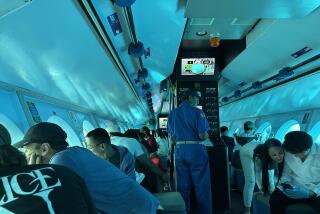Appropriate Sub-stitute for Diving in Caymans
- Share via
GRAND CAYMAN, British West Indies--During my 18 months on this British Crown colony, a certain timidity born of a past near-drowning incident precluded my enjoying the natural wonders of the clear water that draw the majority of tourists to this Caribbean island.
And so I had to revel, vicariously, in the anecdotes of friends--masked, flippered, tanked-up divers. They told of their experiences in gliding through the silent and mysterious world of waving sea fans and basket sponges and staghorn coral, insinuating themselves into the lives of colorful, friendly if shy marine life warily eyeing the leggy intruders.
Snorkeling, my unfulfilling consolation, literally only skimmed the surface of this inconstant wonderland.
Then recently a modern-day Jules Verne brought to Grand Cayman a 28-passenger submarine, of all things, named the Atlantis to satisfy the curiosity of people who have never experienced eyeball-to-eyeball confrontations with the piscine colonies. “Now the Atlantis opens up the underwater world to everyone,” says Barry Bellchambers.
$2.8-Million Cost
Bellchambers, bearded, Australian-born, is the vice president of Sub Aquatics Development Corp. of Vancouver, Canada, where the Atlantis was built at a cost of $2.8 million. It is the only submarine of its kind in the world, although a second is being constructed in time for Expo 86 in Vancouver.
The 50-foot sub was trundled the 4,000 miles from Vancouver to Miami, where it arrived last November, to be shipped to Georgetown, capital of the Cayman Islands.
Perhaps winter’s early presence had already numbed the imagination of northerners, for Bellchambers says it was not until it arrived in south Florida that his subterranean marvel fashioned of steel, aluminum and fiberglass attracted inquisitive newspapermen.
Now it is based a couple of hundred yards from Georgetown’s inelegantly named Hog Sty Bay, where tenders disgorge passengers from the up to eight cruise ships, mostly Miami-based, that call here weekly for a day on their Caribbean itineraries.
Eden Rock, the underwater playground just offshore that the Atlantis explores, has long been popular with snorkelers; the spectacle of scores of these begoggled sightseers plumbing the depths gives new meaning to the toast “Bottoms up.”
Two-Foot Portholes
Passengers on the 50-ton sub sit back-to-back, each two sharing one of the two-foot-wide portholes. The pilot sits between an array of instruments on two control panels.
The similarity of the submarine experience to that of riding in an airplane is obvious also in the “just in case” presence of respirators and life jackets, although Bellchambers said that in the event of a power failure the Atlantis would rise automatically to the surface. It also has a 72-hour support system.
On the surface, following the Atlantis’ progress closely, and never more than 20 yards away, is a small pilot boat whose occupant is in touch with the Atlantis crew by telephone to warn if it turns onto a collision course with some unwary object, like a school of preoccupied divers.
So what’s to see down there? Bellchambers doesn’t try to emulate Verne’s Capt. Nemo, who took his Nautilus 20,000 leagues; the Atlantis is content to glide at a smooth one knot to a depth of about 60 feet, where it rests gently on the ocean floor.
Tapestry of Creatures
On the way, passengers are treated voyeuristically to the personal habits of a mind-stirring variety of fish of all shapes and sizes: querulous rock beauties, unconcerned sergeant majors, darting damsel fish, casual tarpon, snappers and butterfly fish.
At times it seems as if a brilliant blue curtain has been dropped so that the viewer’s gaze is enveloped by a tapestry of dancing sea creatures hovering over the living coral. And the trails of conchs, those tough but prized shellfish, criss-cross on the sandy bottom like railroad tracks.
If daytime sub dives are pleasurable enough, night trips can be even more dazzling. Lights around the Atlantis pick out denizens of the sea, nocturnal creatures such as the octopus and the moray eel.
The dry runs on the Atlantis cost $45 by day, $55 by night.
More to Read
Sign up for The Wild
We’ll help you find the best places to hike, bike and run, as well as the perfect silent spots for meditation and yoga.
You may occasionally receive promotional content from the Los Angeles Times.






